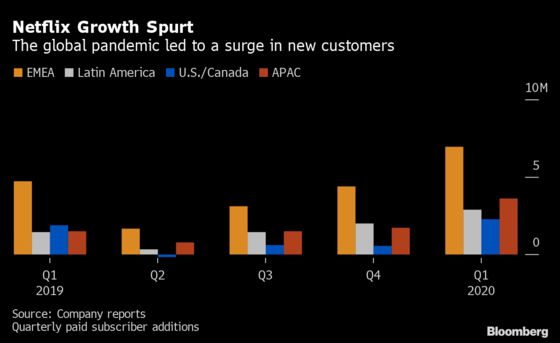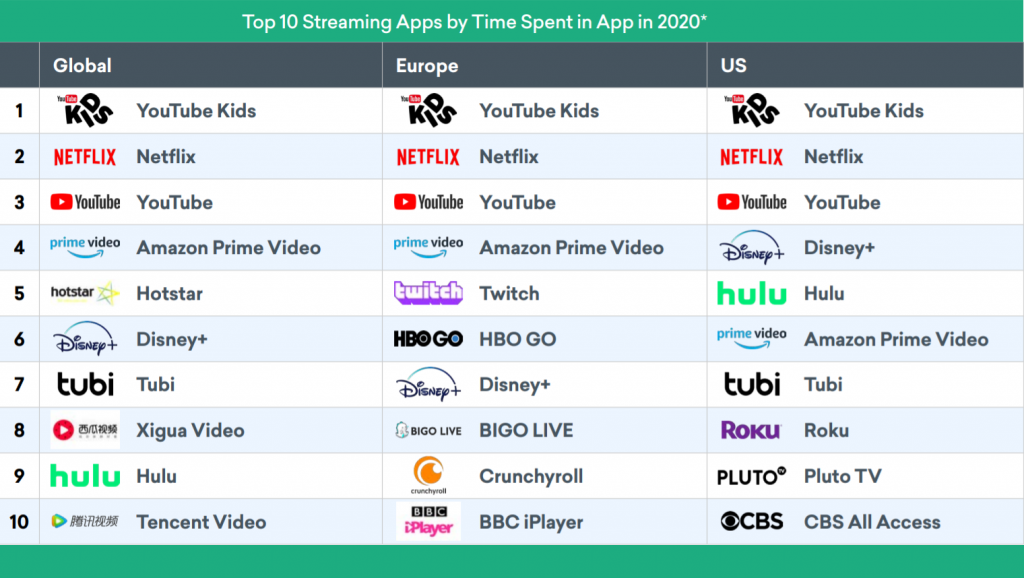Video streaming industry expected to grow to $150 billion by 2026
According to the latest research, the video streaming industry is expected to grow to $150 billion by 2026 at CAGR of 18%.
In this article:
- Video streaming industry stats and facts
- Key factors driving the video streaming industry growth
- Key restraining factors for the growth of video streaming industry
- Opportunities
Video streaming industry stats and facts
![]() Due to lockdown, Internet users are spending 32% of their time on streaming devices and platforms (Market);
Due to lockdown, Internet users are spending 32% of their time on streaming devices and platforms (Market);
 54% of Internet users are watching more shows and films on streaming services due to Covid-19 (Market);
54% of Internet users are watching more shows and films on streaming services due to Covid-19 (Market);
 Key players in the video streaming software market: IBM, Vimeo, Brightcove, Qumu, Kaltura, Wowza etc;
Key players in the video streaming software market: IBM, Vimeo, Brightcove, Qumu, Kaltura, Wowza etc;
 Key players in the VoD market: Netflix, Hulu, Disney, HBO, Apple, Google, AT&T, Amazon, YouTube;
Key players in the VoD market: Netflix, Hulu, Disney, HBO, Apple, Google, AT&T, Amazon, YouTube;
 Media and Entertainment, BFSI, Healthcare, and Academia and Education, eCommerce contribute to ~60-70% of the market;
Media and Entertainment, BFSI, Healthcare, and Academia and Education, eCommerce contribute to ~60-70% of the market;
 The fastest-growing video streaming market is China. China’s live-streaming industry has more than doubled in size compared with the previous year, reaching now $5 billion (Researchgate);
The fastest-growing video streaming market is China. China’s live-streaming industry has more than doubled in size compared with the previous year, reaching now $5 billion (Researchgate);
 In India, the video streaming industry is projected to reach $465 million by the end of 2020 (Statista)
In India, the video streaming industry is projected to reach $465 million by the end of 2020 (Statista)
 The largest video streaming market is the US. Here the video streaming industry is projected to reach $24 billion in 2020 (Statista)
The largest video streaming market is the US. Here the video streaming industry is projected to reach $24 billion in 2020 (Statista)
 The fastest-growing segments in the video streaming industry are:
The fastest-growing segments in the video streaming industry are:
- Video Analytics. Video analytics allow service providers to better understand their audiences, serve them better and thus, remain competitive.
- Live streaming. Live streaming helps audiences feel more engaged and more connected with the person in front of the camera.

Key factors driving the video streaming industry growth
 Increasing penetration of mobile devices and internet users
Increasing penetration of mobile devices and internet users
In 2020, the number of global smartphone users is projected to total 3.5 billion, marking a 9.3% increase from 2019. The current global population of 7.7 billion people means the smartphone penetration rate is at 45.4 %. (Oberlo)
Almost 4.66 billion people were active internet users as of October 2020, encompassing 59% of the global population. Mobile has now become the most important channel for internet access worldwide as mobile internet users account for 91% of total internet users. (Statista)
 Growing demand for VoD streaming
Growing demand for VoD streaming
According to Cisco, video will account for 82% of all Internet traffic by 2022.
 Remote work & Lockdown
Remote work & Lockdown
The COVID-19 pandemic has had serious consequences on business too with a large number of employees working remotely.
More than 1/4th of the world’s population went into lockdown. This has resulted in increased demand for online streaming and entertainment services.
Netflix added 26 million new subscribers in the first six months of 2020 which accounts for the company’s biggest growth spurt in history. As of the third quarter of 2020, Netflix had 195.15 million paid subscribers worldwide. (Forbes)

Disney+ launched a year ago with the goal of reaching 60 million to 90 million subscriptions by 2024. The company has recently announced that the platform surpassed 74 million subscribers by the end of 2020, outperforming all expectations. (CNBC)
Apple TV+ also launched a year ago and is included in the company’s One subscription bundle. The company hasn’t released any info regarding the number of its paying subscribers but estimations range from 10 million to 40 million subscribers. (TheVerge)
As of January 2020, there are over 150 million Amazon Prime Video users. (Market)
 Growing adoption of cloud-based solutions
Growing adoption of cloud-based solutions
The global public cloud service market is projected to reach $266 billion in 2020. This spells out a projected growth of 17.3% since 2018. According to Gartner’s forecast, infrastructure-as-a-service (IaaS) solutions, like cloud storage, will be the fastest-growing segment of the market with 24% predicted growth. (Hosting Tribunal)
 Growing demands of Live Video streaming solution
Growing demands of Live Video streaming solution
Over the past few years, going live on Facebook has become a popular feature among its users. Today live video is on almost every social platform: Instagram, Twitter, LinkedIn, Snapchat, YouTube etc.
 Technology innovations like blockchain and AI
Technology innovations like blockchain and AI
Video streaming as a service relies entirely on technology. Video streaming is not possible without video storage, encoding, networking and streaming. Blockchain technology expands storage options by spreading data across the blockchain computer network. Streaming video will be able to tap into underutilized computers through the Blockchain, which will dramatically reduce streaming’s cost (learn more).
From face recognition to chatbots and disease mapping, AI has a wide range of applications across many verticals. In video streaming, AI helps with workflow optimization, content-aware encoding and bandwidth use optimization while maintaining an appropriate level of quality. The main benefit of using AI in video streaming is cost saving.

Key restraining factors for the growth of video streaming industry
- connectivity issues;
- latency and bandwidth issues which may result in poor quality video;
- a surge in internet traffic;
- data loss due to buffering;
- the disparity among software systems;
- high content cost;
- easy availability of pirated data;
- loss of personal and financial details.

Opportunities
Over the past few years, digital transformation has been in the top three goals for businesses everywhere.
The pandemic-induced lockdown forced businesses that had already started down this path to speed up and businesses that had a traditional high-street or in-person revenue generation model to pivot toward online and digital.
As a result, this year has seen teachers teach classes online to students ranging from first-graders to executive MBA participants.
Doctors see their patients through their PC’s camera first and popular talk show hosts broadcast from their homes.
Live music and business events have gone online, each of them looking to provide attendees with the best experience possible.
International banks with thousands of branches worldwide are making the most of the digital environment allowing their clients to keep safe.

Conclusion
Video streaming industry is projected to grow to $150 billion by 2026.
The industry has been growing steadily in recent years but the pandemic has accelerated its growth.
Remains to be seen if the industry will maintain its growth rate after the pandemic is over.
Join the Conversation
We’d love to hear what you have to say.
Get in touch with us on our LinkedIn Page, Facebook Page, Twitter or TikTok.
Less known things that might surprise you about technology in general
One of the first Computer Science Ph.Ds was earned by a nun
Sister Mary Kenneth Keller, born in Ohio in 1914, entered the Sisters of Charity in 1932 and professed her vows in 1940. She went on to study at DePaul University, where she received a B.S. in Mathematics and an M.S. in Mathematics and Physics. n 1965, she became the first American woman to earn a Ph.D. in Computer Science. Afterwards, Sister Keller founded the computer science department at Clarke College in Iowa, which she directed for 20 years. She was passionate about providing access and information to everyone, not just computer scientists. She also envisioned a world in which computers made people smarter and learned to think on their own.
Changing fonts can save printer ink
Some say that if you use a ‘lighter’ font (with a lighter stroke), you’ll use slightly less ink per page. Based on the assumption that you’re only printing with inkjet printers that use the old style cartridges (not ink tanks, and not toner based laser printers), you’ll likely save about 10 per cent ink by switching to one of the lighter fonts.
QWERTY was designed to slow you down

There are actually two theories to this. The first one starts to make sense when you look at manual typewriters. If someone typed too fast, the keys would jam. QWERTY placed common alphabets at a distance from each other and slowed typists down. Another theory is that telegraph operators designed the QWERTY layout because it was easier (and faster) to decipher Morse code.
92 per cent of the world’s currency is digital

This means that most of the money you earn, transact with, use to buy goods/services and so on exists only on computers and hard drives. Only an estimated 8 per cent of currency globally is physical money. Banks store electronically too and the 92 per cent includes all kinds of transactions done using credit/debit cards and wire transfers.
Russia built a computer that ran on water, in 1936
Before the miniaturization of transistors, computers had a much more visible system of counting: things like gears, pivots, beads and levers were often used and they needed some sort of power source to function. Vladimir Lukyanov built something like this in 1936, but he used water to create a computer that solved partial differential equations. In images of the Lukyanov computer, you’ll see a complex system of interconnected tubes filled with water. It was also called a Water Integrator and was originally designed to solve the problem of cracking in concrete. It’s now found in Moscow’s Polytechnic Museum.
The first mouse was made of wood

It was created by Doug Engelbart, with the assistance of Bill English, during the 1960’s and was patented on November 17, 1970. According to computerhope.com, the mouse was originally referred to as an “X-Y Position Indicator for a Display System” and was first used with the Xerox Alto computer system in 1973. Using the mouse, Douglas was able to demonstrate moving a mouse cursor on the Alto computer in The Mother of All Demos. However, because of its lack of success, the first widely used mouse is the mouse found on the Apple Lisa computer.
A killer may have gone free due to using Firefox
The Florida sheriff’s office that investigated Caylee Anthony’s death confirmed that it overlooked a computer search for suffocation methods made from the little girl’s home on the day she was last seen alive. WKMG reports that sheriff’s investigators pulled 17 vague entries only from the computer’s Internet Explorer browser, not the Mozilla Firefox browser commonly used by Casey Anthony. More than 1,200 Firefox entries, including the suffocation search, were overlooked.
The data can be corrupted by high-energy particles coming from the space

According to makesenseof.com, some scientists have suggested that Toyota’s unintended acceleration fiasco may have been caused by the interference of cosmic rays combined with inadequate fail-safes for recovering from randomly introduced errors. For most PC users, however, invaders from outer space are not the most likely source of trouble. Good ole-fashioned human error is a more common cause. Corruption usually occurs because of user error (deleting or modifying files that shouldn’t be tampered with), malicious activity (malware) or routine degradation and failure of storage media (mechanical and solid state drives).
The first ever webpage still exists at its place
Invented by Tim Berners Lee, the first website went live at research lab CERN in 1990. Created by 60-year-old British computer scientist Tim Berners-Lee in 1990, while he was a researcher at the European Organization for Nuclear Research (CERN), the website still exists today. The site’s address is info.cern.ch, and provides information about the world wide web – the platform that sits on top of the Internet, where documents and pages on the Internet can be accessed by URLs, and connected to each other via hyperlinks.

And, on a lighter tone…
- In 2012, at least 17 newborn girls were named Siri
- A red panda is native to the Himalayas and southwestern China. Translated, the English word for red panda is “Firefox,” which is where the browser gets its name.
- The world’s first camera took eight hours to snap a photo.
- About 1 out of 8 married couples actually met each other on the Internet.
- There is a factory in Japan which can run unsupervised for 30 days at a time — it’s almost entirely manned by robots.
- In Mexico City, there are special bins that offer free wifi to people who properly dispose of their dog poop.
- On an average day, a typist’s hands fingers travel 12.6 miles.
- The first banner advertising was used in 1994.
- Two hundred and twenty million tons of old computers and other technology devices are trashed in the United States each year.
Online identity protection – 10 simple tips
source: medibid
Up to 9 million Americans have their identities stolen each year according to the FTC , and at least 534 million personal records have been compromised since 2005 through attacks on the data bases of businesses, government bodies, institutions, and organizations. For some consumers, identity theft is an annoying inconvenience and they can quickly resolve their problems and restore their identity. For others, recovering their identity can cost hundreds, even thousands of dollars, take months to resolve, cause tremendous damage to their reputation, cause them to lose job opportunities, even influence the rejection of loan applications for school, homes or cars because would-be employers or loan companies see the damage on your credit scores.
In order to help you prevent these types of situations, here are some tips & tricks you should follow:
- Protect your computer and smartphone with strong, up-to-date security software. If your computer or phone is infected with malicious software, other safeguards are of little help because you’ve given the criminals the key to all your online actions. Also be sure that any operating system updates are installed.
- Learn to spot spam and scams. Though some phishing scams are easy to identify, other phishing attempts in email, Instant Messaging, on social networking sites, or websites can look very legitimate. The only way to never fall for phishing scam is to never click on a link that has been sent to you by someone you don’t know, looks suspicious or from a third party that you didn’t request the information from.
- Use strong passwords. Weak passwords are an identity thief’s dream – especially if you use the same password everywhere. You need passwords that are long (over 10 characters), strong (use upper and lower case letters, numbers and symbols), and that have nothing to do with your personal information (like name, age, birth date, pet)

- Use multiple passwords. Have more than one password for online accounts or – if it’s cracked – thieves will be able to gain access to all your private data at once.
- Freeze your credit. Criminals use stolen ID’s to open new lines of credit. You can thwart their efforts to use your identity by simply locking (called freezing) your credit so that no new credit can be given without additional information and controls.
- Monitor & review your credit scores and bank data. Look too see if there are new credit cards, loans or other transactions on your account that you are not aware of. If there are, take immediate steps to have these terminated and investigated.
- Only use reputable websites when making purchases. If you don’t know the reputation of a company that you want to purchase from, do your homework. How are they reviewed by other users? Do they use a secure, encrypted connection for personal and financial information?
- Stay alert. Watch for common signs of identity theft like:
- false information on your credit reports, including your personal numeric code, address(es), name or employer’s name.
- Missing bills or other mail. If your bills don’t arrive, or come late, contact your creditors. A missing bill may indicate that an ID thief has hijacked your account and changed your billing address to help hide the crime.
- Getting new credit cards sent to you that you didn’t apply for.
- Having a credit approval denied or being subjected to high interest rates for no apparent reason.
- Receiving calls or notices about past due bills for products or services you didn’t buy.
- Exclude important personal information from your social media profile. On Facebook, that means culling any ‘friends’ you don’t know, minimizing the details in your ‘About Me’ section and being selective about hitting the ‘like’ button, all of which will make you harder to find.source: backtoyourcountrynavigator
- Check your social media & phone privacy settings. Change all Facebook settings to “Friends Only” for all posts for a more secure profile. Facebook often makes changes to these settings and, when it does so, can even reset your secure settings. Moreover, turning your GPS location settings to “off” can also keep your family’s whereabouts more private.
